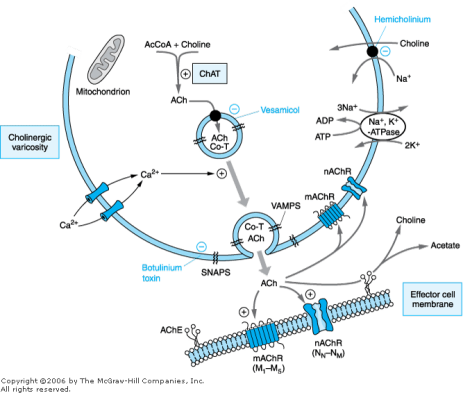
Schematic representations of a cholinergic neuroeffector junction showing features of the synthesis, storage, and release of acetylcholine (ACh) and receptors on which ACh acts.
The synthesis of ACh in the varicosity depends on the uptake of cholinevia a sodium-dependent carrier. This uptake can be blocked by hemicholinium. Choline and the acetyl moiety of acetyl coenzyme A, derived from mitochondria, form ACh, a process catalyzed by the enzyme choline acetyltransferase (ChAT). ACh is transported into the storage vesicle by another carrier that can be inhibited by vesamicol. ACh is stored in vesicles along with other potential cotransmitters (Co-T) such as ATP and VIP at certain neuroeffector junctions. Release of ACh and the Co-T occurs on depolarization of the varicosity, which allows the entry of Ca2+ through voltage-dependent Ca2+ channels. Elevated [Ca2+]in promotes fusion of the vesicular membrane with the cell membrane, and exocytosis of the transmitters occurs. This fusion process involves the interaction of specialized proteins associated with the vesicular membrane (VAMPs, vesicle-associated membrane proteins) and the membrane of the varicosity (SNAPs, synaptosome-associated proteins). The exocytotic release of ACh can be blocked by botulinum toxin. Once released, ACh can interact with the muscarinic receptors (mAChR), which are GPCRs, or nicotinic receptors (nAChR), which are ligand-gated ion channels, to produce the characteristic response of the effector. ACh also can act on presynaptic mAChRs or nAChRs to modify its own release. The action of ACh is terminated by metabolism to choline and acetate by acetylcholinesterase (AChE), which is associated with synaptic membranes.